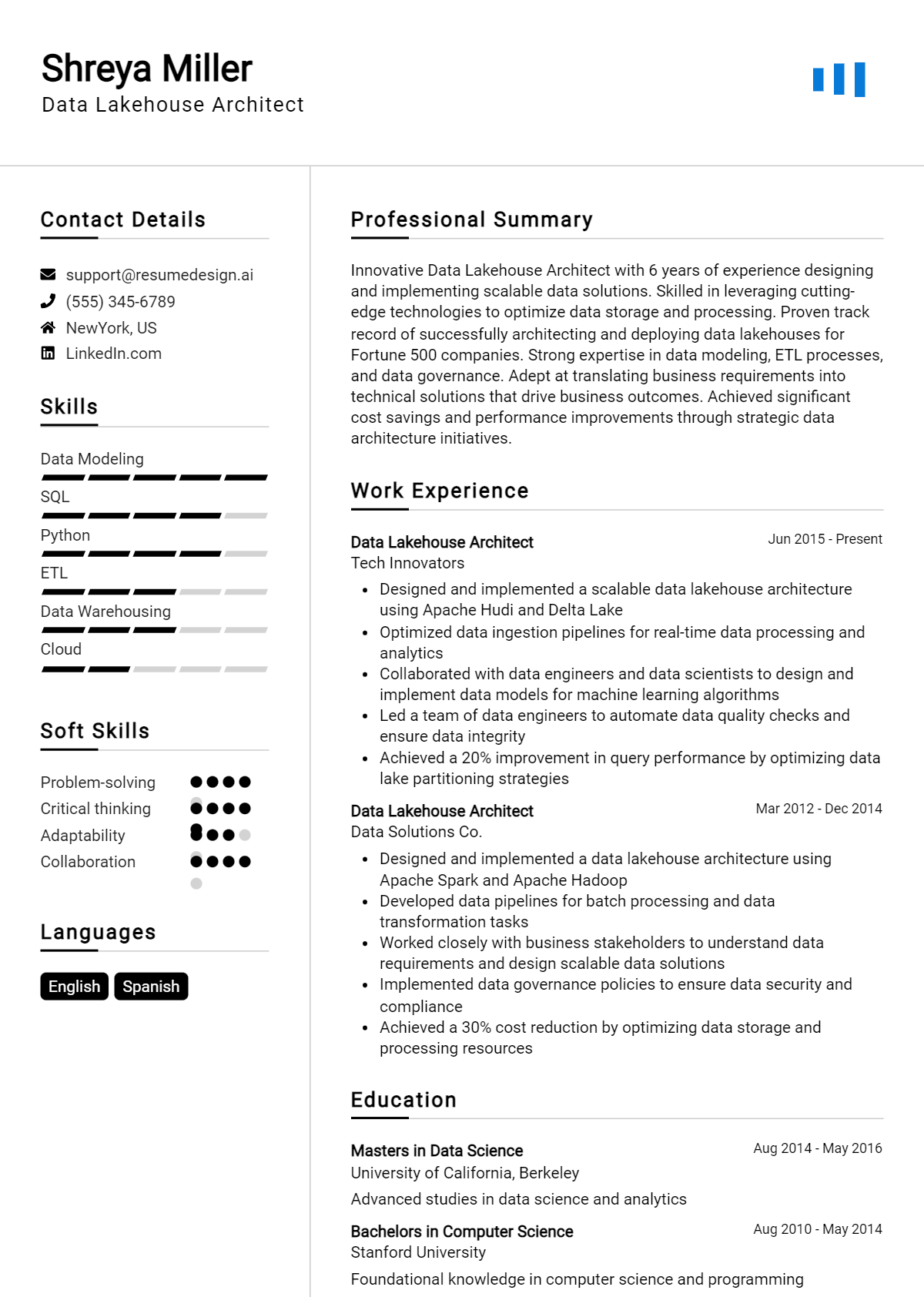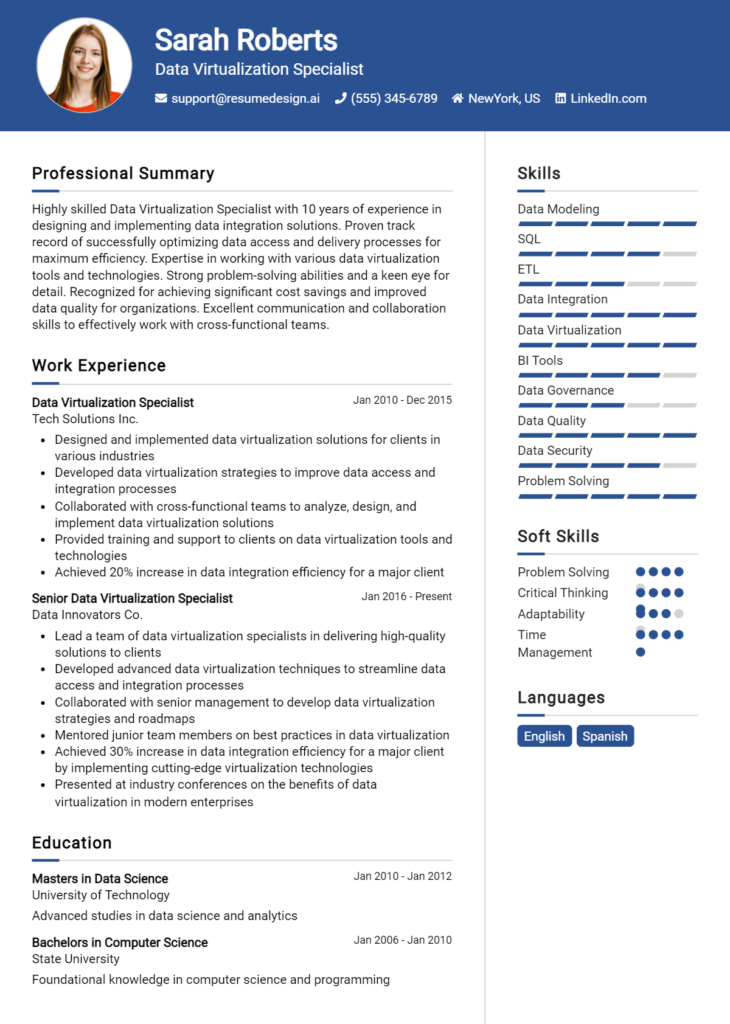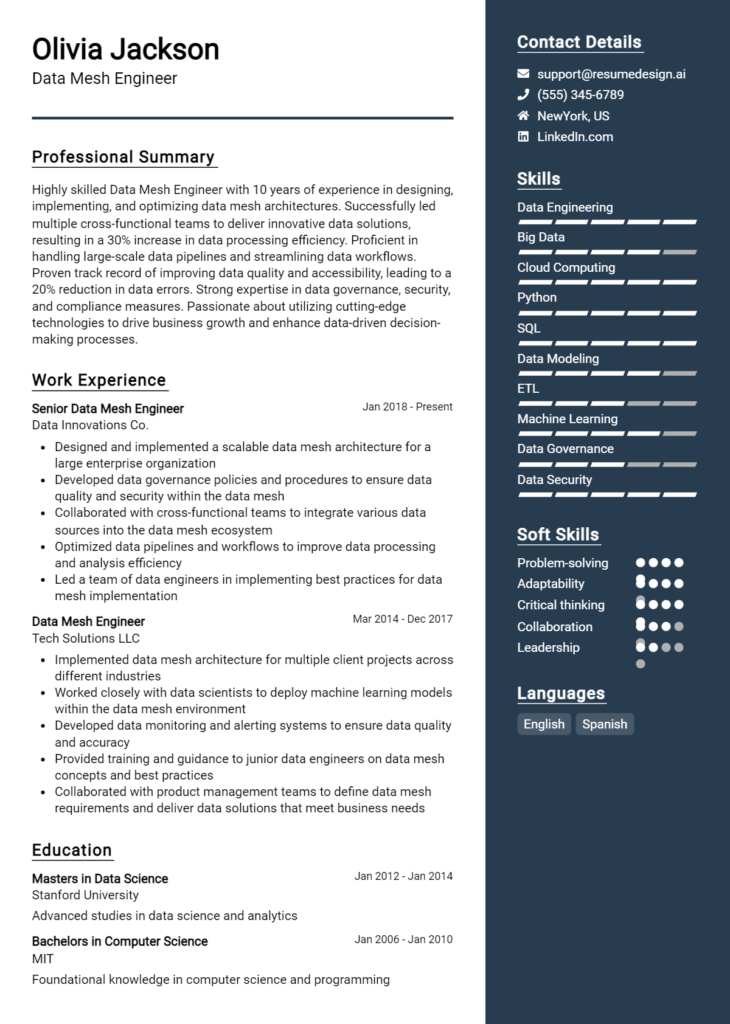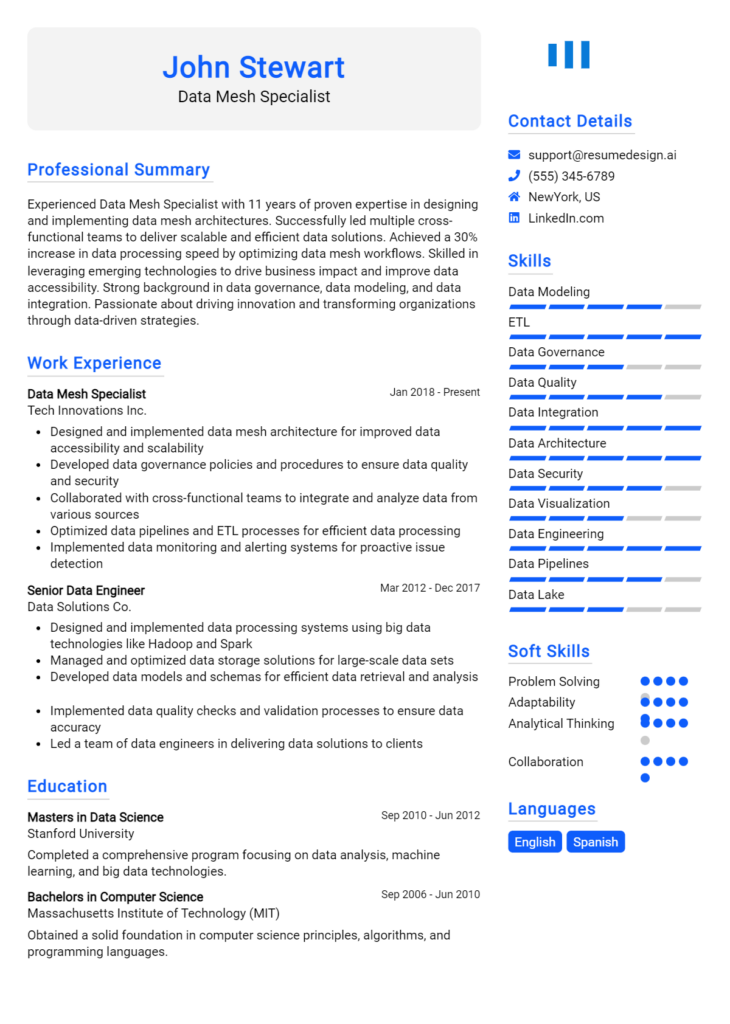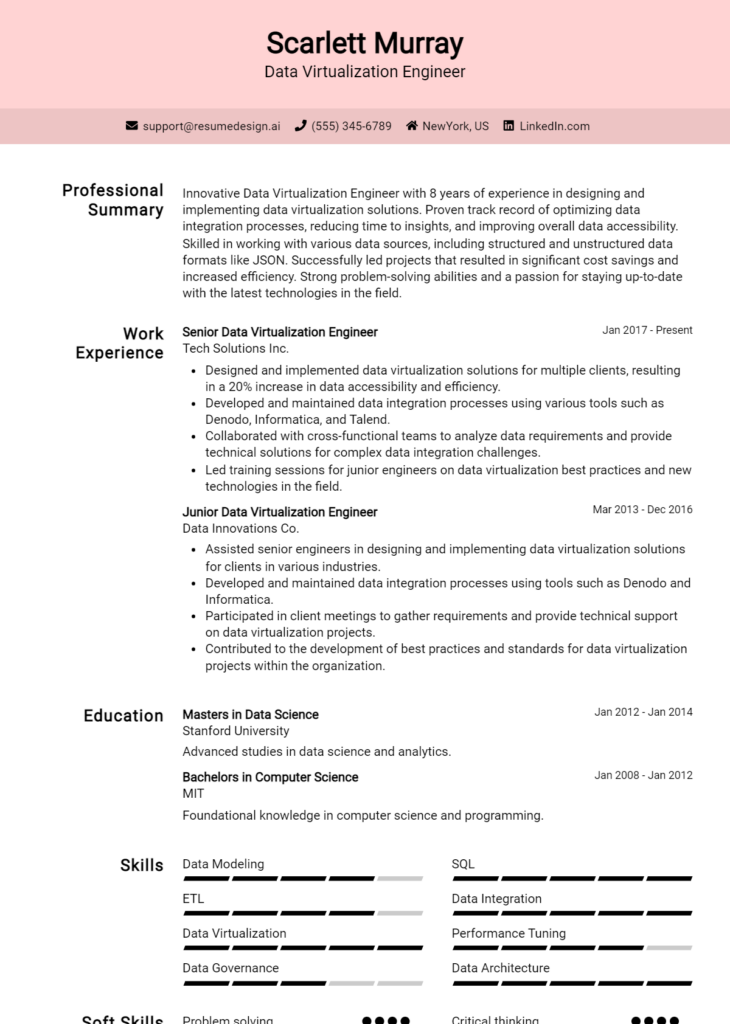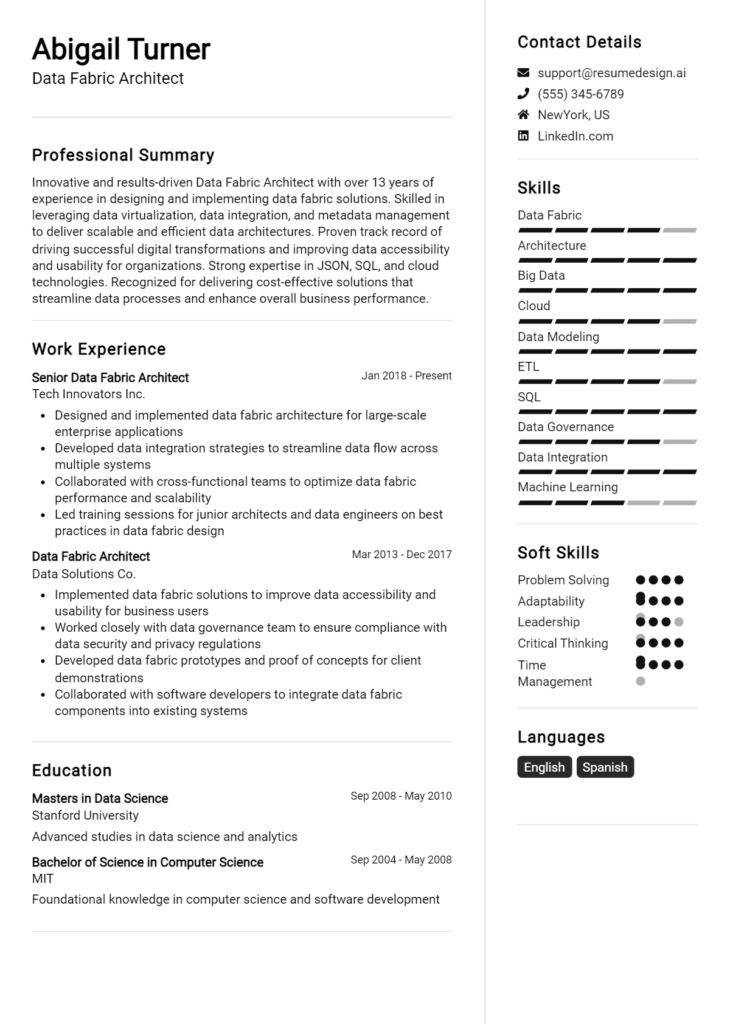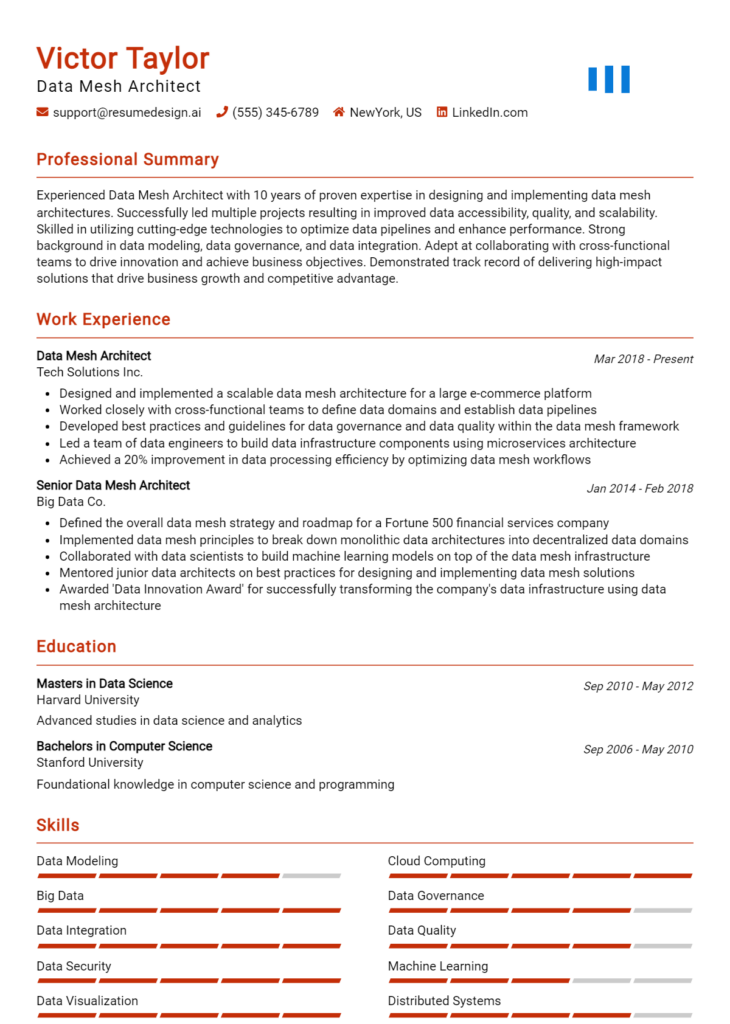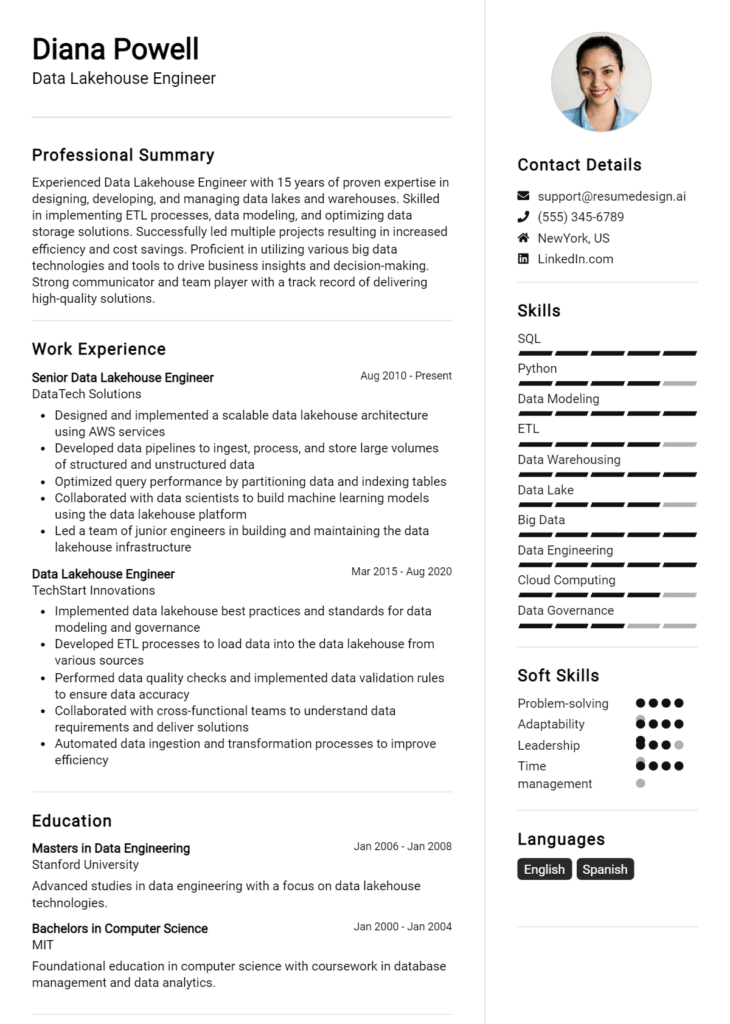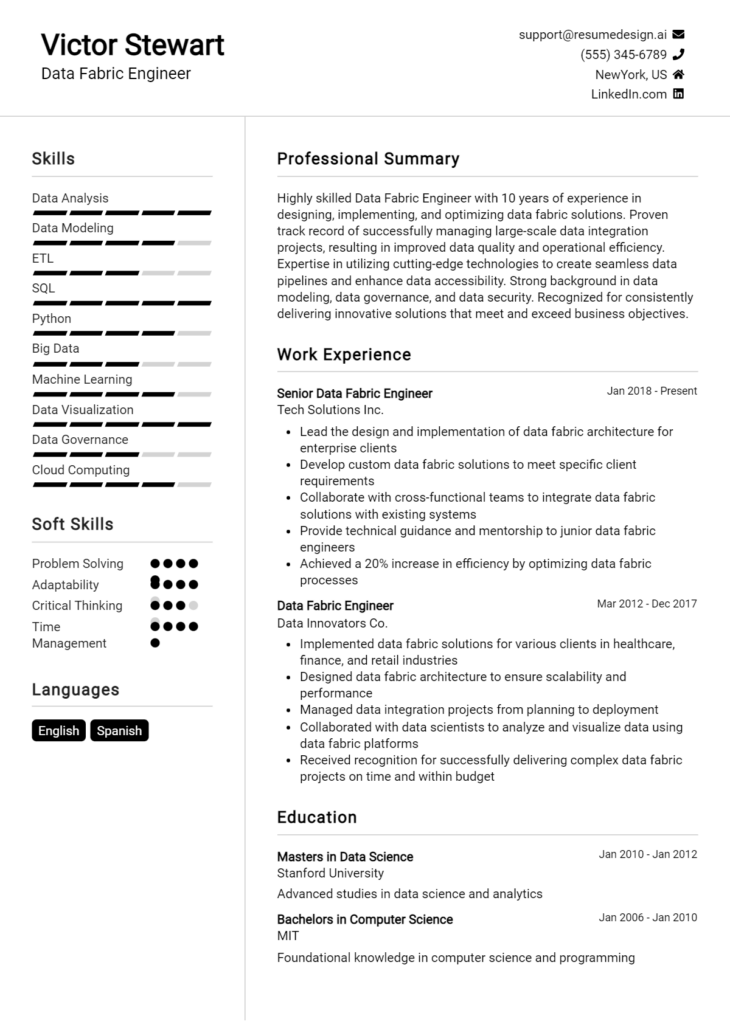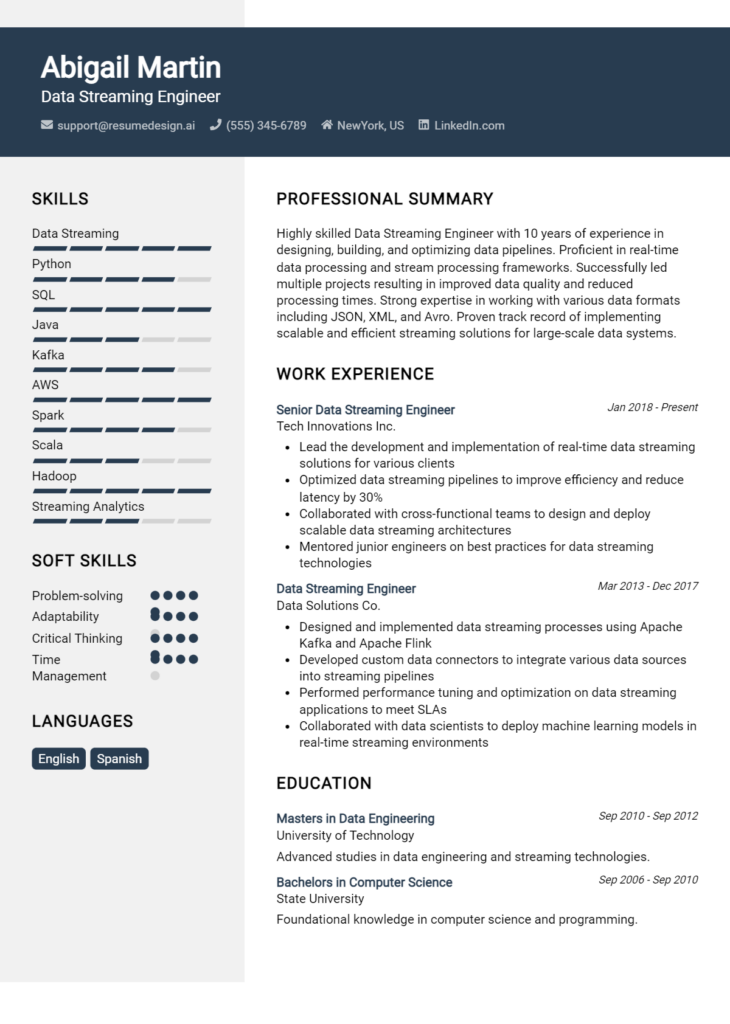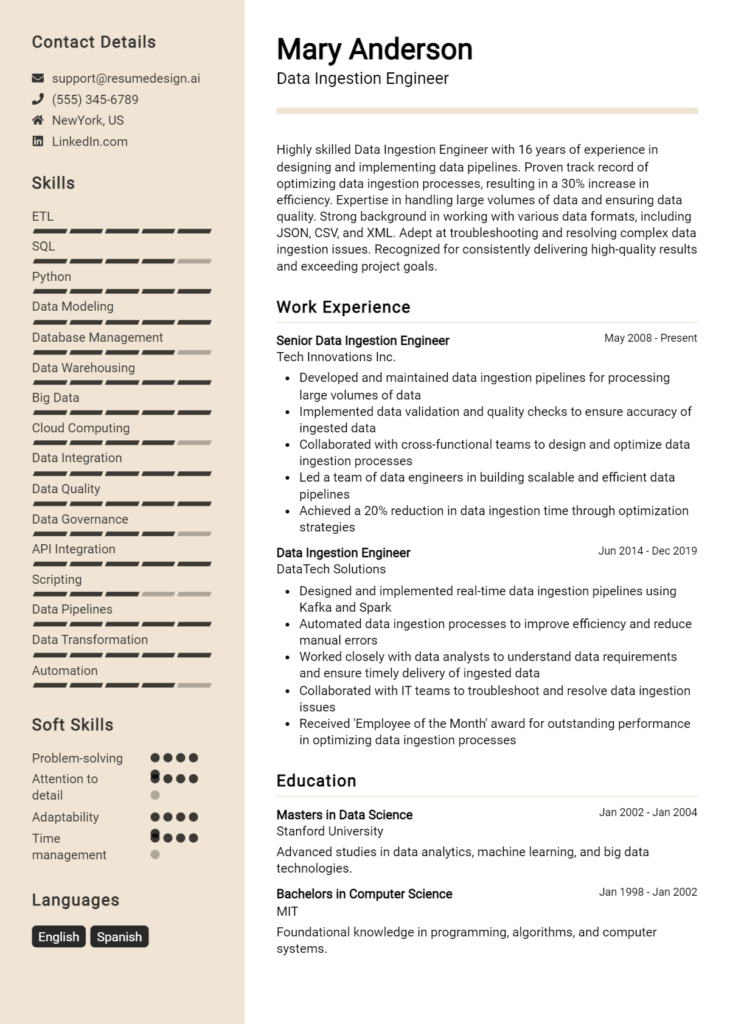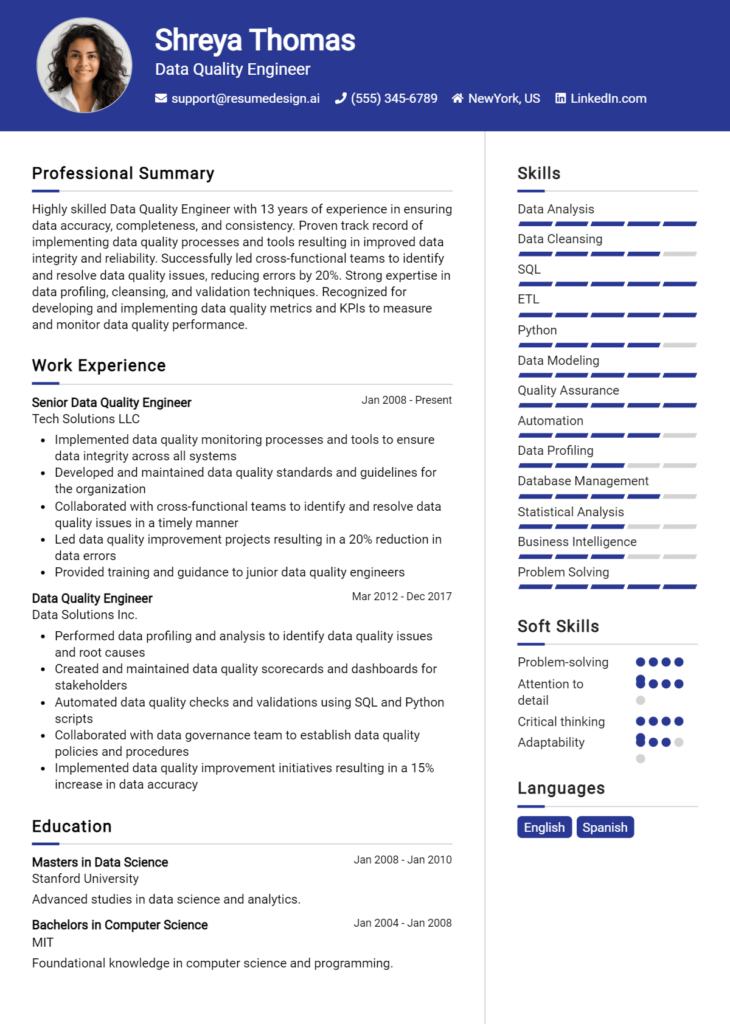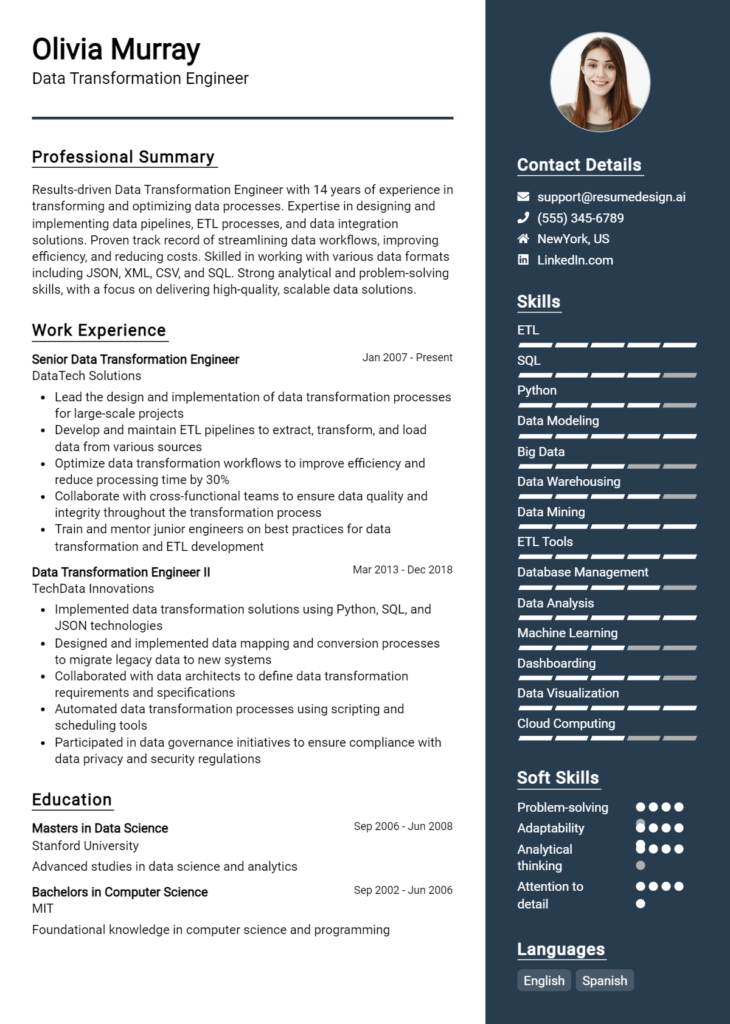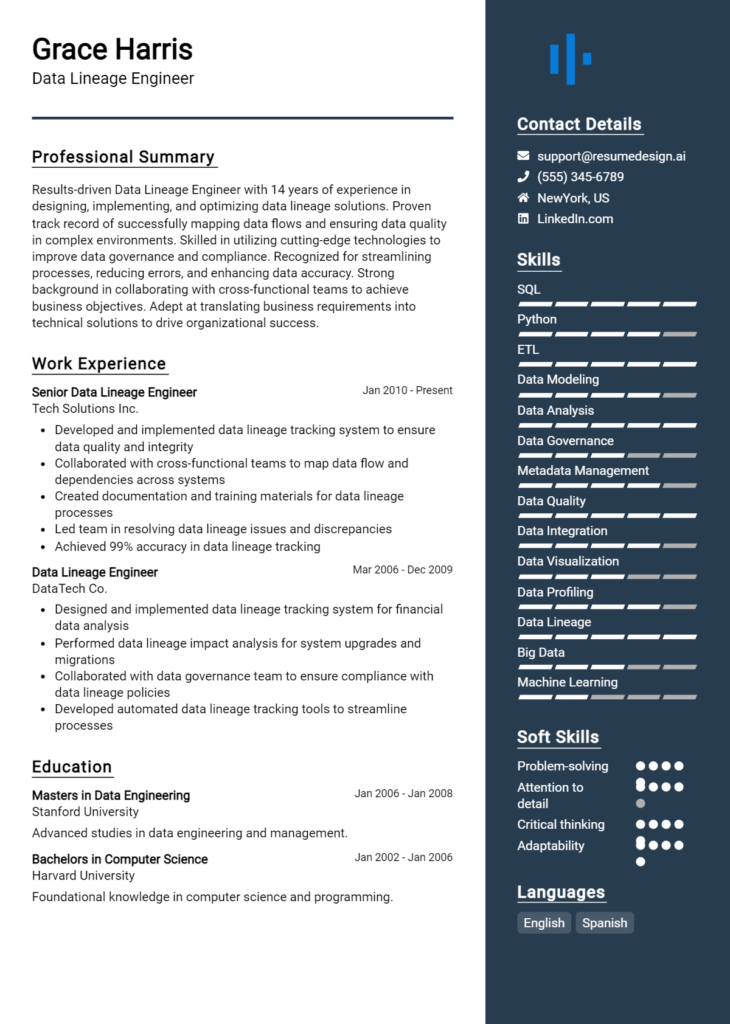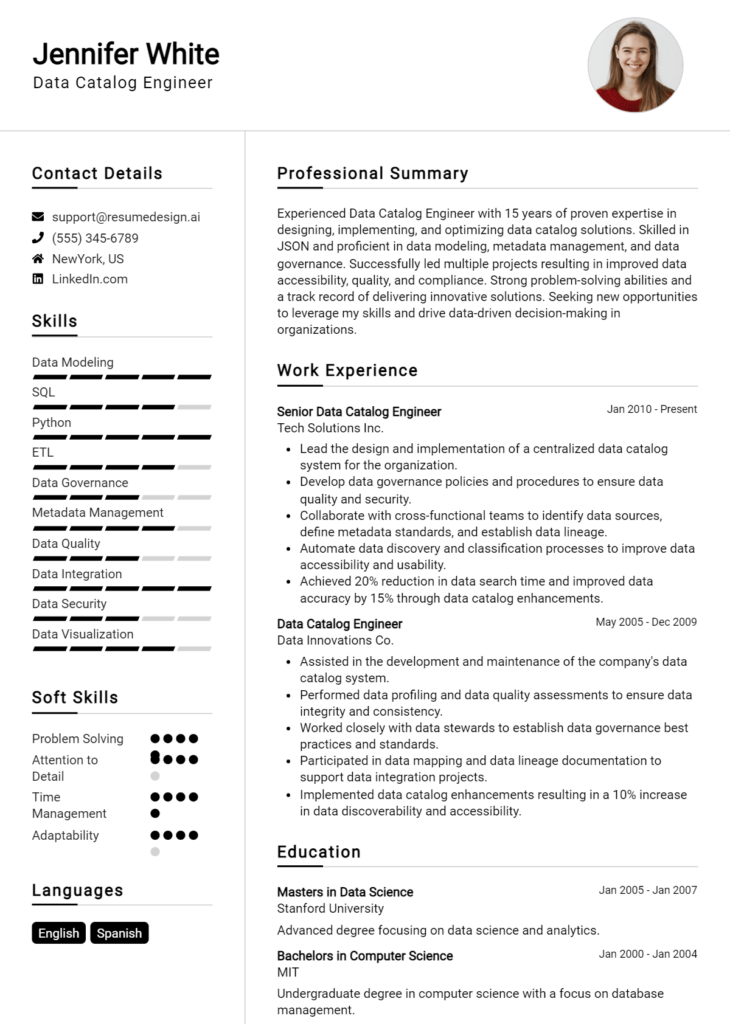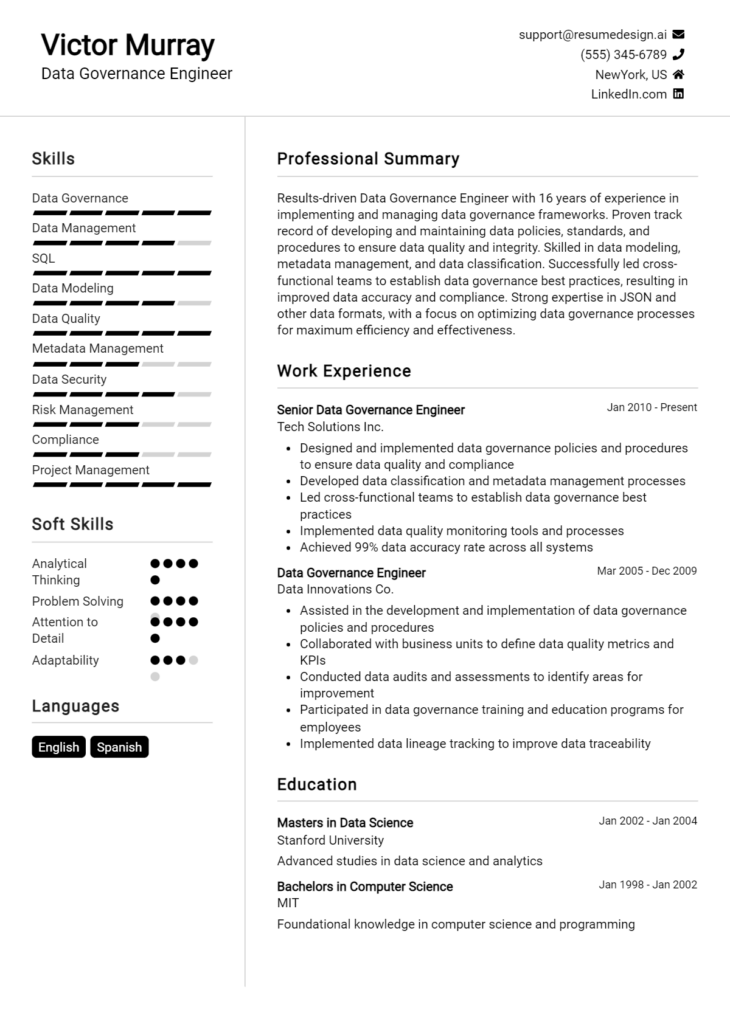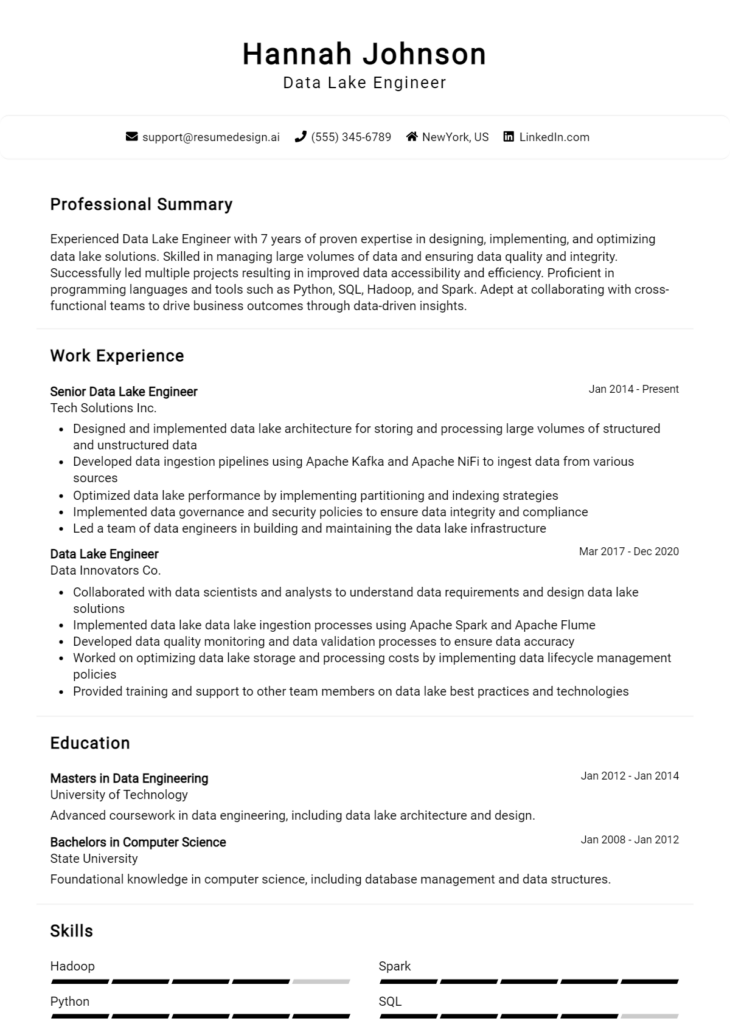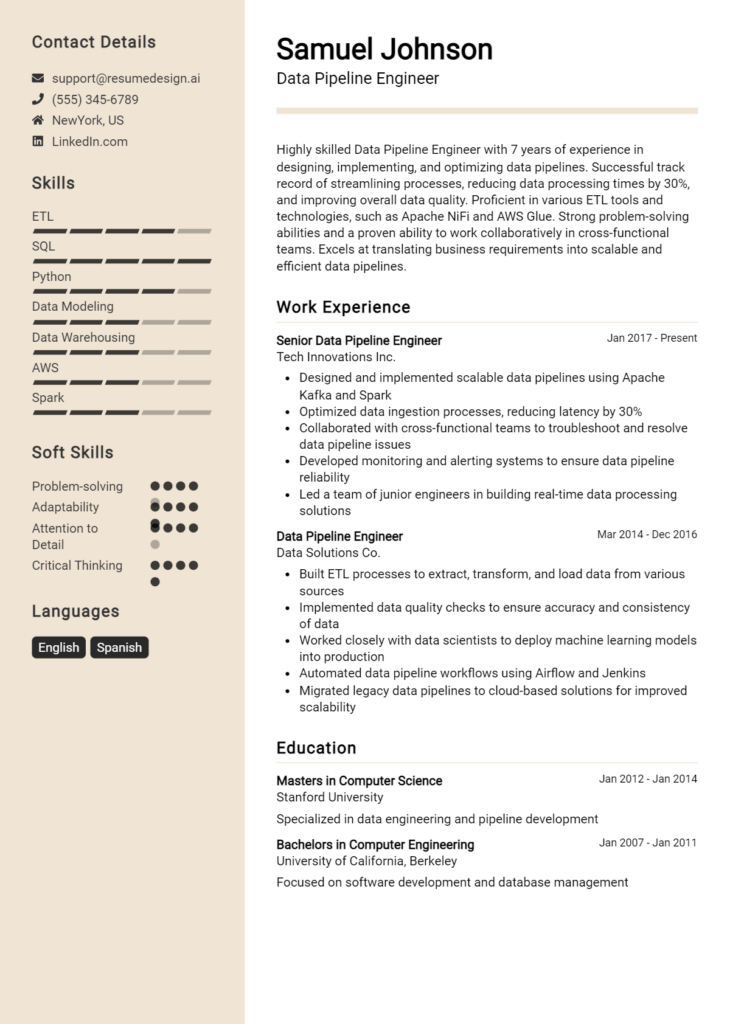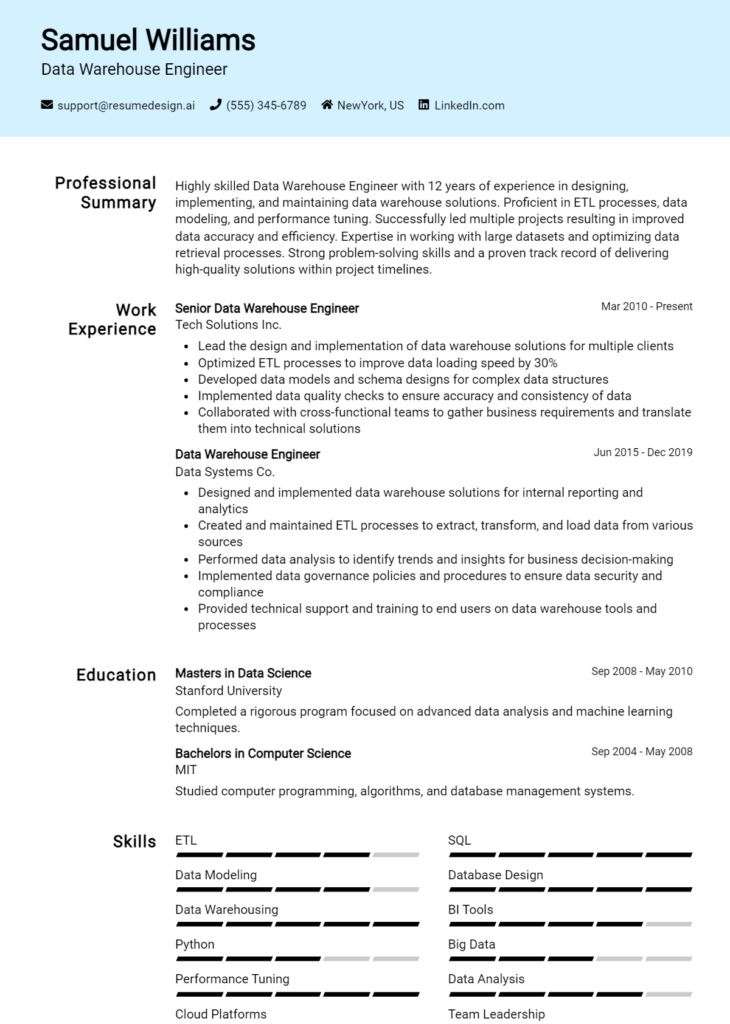Data Lakehouse Architect Core Responsibilities
A Data Lakehouse Architect plays a pivotal role in integrating data across various departments to enhance analytics and decision-making processes. This professional is responsible for designing and maintaining the architecture that unifies data lakes and data warehouses, ensuring data quality and accessibility. Essential skills include advanced technical expertise in cloud platforms, data modeling, and ETL processes, as well as strong operational and problem-solving abilities. A well-structured resume can effectively highlight these qualifications, demonstrating how they contribute to the organization’s strategic goals.
Common Responsibilities Listed on Data Lakehouse Architect Resume
- Design and implement scalable data lakehouse architectures.
- Collaborate with cross-functional teams to understand data requirements.
- Oversee data ingestion, transformation, and storage processes.
- Ensure data governance and compliance with industry standards.
- Optimize performance of data processing and querying.
- Develop and enforce data management best practices.
- Conduct regular audits to ensure data integrity and accuracy.
- Implement security measures to protect sensitive data.
- Stay updated on emerging technologies and industry trends.
- Provide technical guidance and support to data teams.
- Document architecture designs and data workflows comprehensively.
- Facilitate training sessions for stakeholders on data usage and tools.
High-Level Resume Tips for Data Lakehouse Architect Professionals
In the competitive landscape of data architecture, a well-crafted resume is essential for Data Lakehouse Architect professionals. As the first impression a candidate makes on a potential employer, the resume must effectively showcase both skills and achievements in a concise manner. It serves as a powerful marketing tool, highlighting unique qualifications that set the candidate apart from others in the field. This guide will provide practical and actionable resume tips specifically tailored for Data Lakehouse Architect professionals, ensuring that your resume stands out to recruiters and hiring managers alike.
Top Resume Tips for Data Lakehouse Architect Professionals
- Tailor your resume to each job description by incorporating relevant keywords that match the specific requirements and responsibilities outlined by the employer.
- Highlight your experience with popular data lakehouse technologies such as Apache Iceberg, Delta Lake, and Databricks to demonstrate your technical proficiency.
- Quantify your achievements by including metrics such as performance improvements, cost reductions, or data processing speeds to provide tangible evidence of your impact.
- Showcase your understanding of data governance, security, and compliance best practices to address the critical concerns of potential employers.
- Include relevant certifications, such as those from cloud providers (AWS, Azure, GCP) or data management organizations, to validate your expertise and commitment to professional development.
- List projects that demonstrate your ability to design and implement data lakehouse architectures, emphasizing your role and the successful outcomes of those projects.
- Incorporate soft skills, such as teamwork, communication, and problem-solving, which are crucial for collaboration with cross-functional teams and stakeholders.
- Keep your resume concise and focused, ideally one to two pages, ensuring that every word contributes to showcasing your qualifications and expertise.
- Utilize a clean and professional format that enhances readability, making it easy for hiring managers to quickly assess your qualifications.
By implementing these tips, Data Lakehouse Architect professionals can significantly increase their chances of landing a job in this rapidly evolving field. A resume that effectively showcases relevant skills, experiences, and achievements will resonate with employers, positioning candidates as strong contenders for available roles.
Why Resume Headlines & Titles are Important for Data Lakehouse Architect
In the competitive field of data architecture, a well-crafted resume headline or title plays a crucial role in standing out from a pool of candidates. For a Data Lakehouse Architect, the headline serves as the first impression, summarizing key qualifications and expertise in a concise manner. A strong headline can immediately grab the attention of hiring managers, providing a snapshot of the candidate’s suitability for the role. This vital element should be directly relevant to the job being applied for, ensuring it reflects the specific skills and experiences that make the candidate a perfect fit for the position.
Best Practices for Crafting Resume Headlines for Data Lakehouse Architect
- Keep it concise: Aim for a headline that is brief yet informative, ideally no more than 10-12 words.
- Be role-specific: Tailor the headline to reflect the specific position you are applying for, such as "Data Lakehouse Architect" or "Senior Data Lakehouse Engineer."
- Highlight key skills: Incorporate essential skills or technologies relevant to the role, such as "Expert in Data Integration and Analytics."
- Showcase experience: Mention years of experience or notable accomplishments, e.g., "10+ Years in Data Architecture."
- Use impactful language: Choose powerful and active words that convey confidence and competence.
- Avoid jargon: Ensure clarity by staying away from overly technical terms that may not resonate with all hiring managers.
- Focus on value: Emphasize what you bring to the table, such as "Driving Data-Driven Decisions Through Innovative Solutions."
- Consider formatting: Ensure the headline stands out visually, possibly by using a larger font or bold text.
Example Resume Headlines for Data Lakehouse Architect
Strong Resume Headlines
Innovative Data Lakehouse Architect Specializing in Scalable Solutions
Results-Driven Architect with 10+ Years in Data Lakehouse Implementation
Expert in Data Integration and Analytics for Advanced Lakehouse Architectures
Weak Resume Headlines
Data Architect
Experienced Professional
The strong headlines are effective because they are specific, highlighting the candidate’s unique qualifications and expertise in the field of data lakehouses. They communicate not only the role but also key strengths and years of experience, which can resonate well with hiring managers. In contrast, the weak headlines fail to impress due to their vagueness and lack of relevant details, making it difficult for employers to gauge the candidate’s fit for the role. A strong headline instantly conveys value, while a weak one leaves too much to be desired.
Writing an Exceptional Data Lakehouse Architect Resume Summary
A well-crafted resume summary is crucial for a Data Lakehouse Architect as it serves as the first impression on hiring managers. This brief yet impactful section quickly captures attention by highlighting key skills, relevant experience, and significant accomplishments that align with the demands of the role. A strong summary not only showcases expertise in data architecture and analytics but also reflects an understanding of business needs and technological advancements. It's essential that the summary is concise, impactful, and tailored specifically to the job the candidate is applying for, ensuring it resonates with the employer's requirements.
Best Practices for Writing a Data Lakehouse Architect Resume Summary
- Quantify achievements to provide concrete evidence of your impact (e.g., “increased data processing efficiency by 30%”).
- Focus on relevant skills that are directly aligned with the job description, such as cloud computing, data modeling, and ETL processes.
- Tailor your resume summary for each application to reflect the specific requirements and keywords mentioned in the job listing.
- Use action-oriented language to convey proactivity and results-driven mindset.
- Highlight your experience with specific technologies and tools relevant to data lakehouses, such as AWS, Azure, or Databricks.
- Keep it concise, ideally within 3-5 sentences, to maintain the reader's attention.
- Showcase leadership or collaborative skills if applicable, especially if you've led projects or worked across teams.
- Include any industry-specific knowledge or certifications that may set you apart from other candidates.
Example Data Lakehouse Architect Resume Summaries
Strong Resume Summaries
Dynamic Data Lakehouse Architect with over 8 years of experience in designing and implementing scalable data solutions. Successfully led a team to develop a lakehouse architecture that improved data retrieval speeds by 40%, significantly enhancing analytics capabilities across the organization.
Results-driven Data Lakehouse Architect with expert knowledge in AWS and Azure environments. Achieved a 25% reduction in data processing costs through optimized ETL workflows, while enhancing data security compliance by implementing robust governance frameworks.
Innovative Data Lakehouse Architect with a proven track record of leveraging machine learning algorithms to improve data insights. Spearheaded a project that integrated real-time data streaming, resulting in a 50% increase in operational efficiency.
Weak Resume Summaries
Experienced data professional looking for opportunities in data architecture. Skilled in various technologies and tools.
Data Lakehouse Architect with some experience in the field and a general understanding of data management.
The strong resume summaries are effective because they clearly articulate specific achievements, quantify results, and demonstrate a direct connection to the role of a Data Lakehouse Architect. They showcase relevant skills and experiences that align with the job description, making them compelling to hiring managers. In contrast, the weak summaries are vague and lack detail, failing to provide any measurable outcomes or specific skills that would capture an employer's interest.
Work Experience Section for Data Lakehouse Architect Resume
The work experience section of a Data Lakehouse Architect resume is vital as it serves as a testament to the candidate's technical expertise, leadership abilities, and track record of delivering high-quality data solutions. This section not only highlights the candidate's proficiency in data architecture, cloud technologies, and data management but also illustrates their capability to manage teams effectively and foster collaboration. By quantifying achievements and aligning experiences with industry standards, candidates can enhance their credibility and showcase their potential contributions to prospective employers.
Best Practices for Data Lakehouse Architect Work Experience
- Highlight specific technologies and tools used in projects to demonstrate technical expertise.
- Quantify achievements with metrics, such as performance improvements, cost savings, or time reductions.
- Showcase leadership roles, including team management and project ownership.
- Emphasize collaboration with cross-functional teams to illustrate teamwork and communication skills.
- Align experiences with industry standards and best practices to show relevance and adaptability.
- Include challenges faced and how they were overcome, reflecting problem-solving abilities.
- Tailor the work experience to the job description to highlight the most relevant skills and experiences.
- Use action verbs to convey a sense of impact and initiative in each role.
Example Work Experiences for Data Lakehouse Architect
Strong Experiences
- Led the design and implementation of a scalable data lakehouse solution, resulting in a 30% reduction in data processing time and a 25% increase in analytics performance.
- Managed a cross-functional team of 10 engineers to develop a unified data platform, enhancing collaboration and reducing project delivery times by 40%.
- Successfully migrated legacy data systems to a cloud-based lakehouse architecture, achieving a 50% cost reduction in data storage and access.
- Collaborated with stakeholders to define data governance policies, which improved data quality metrics by 35% across multiple departments.
Weak Experiences
- Worked on various data projects without specific details or outcomes mentioned.
- Assisted in the implementation of data solutions but did not take a leadership role or provide measurable results.
- Involved in team meetings and discussions without mentioning any contributions or impact.
- Helped with data management tasks but did not specify technologies used or improvements made.
The strong experiences listed above are considered impactful because they provide quantifiable results and demonstrate clear leadership and collaboration in significant projects. These statements effectively communicate the candidate's contributions and outcomes, making a compelling case for their capabilities. In contrast, the weak experiences lack specific achievements, metrics, or roles, rendering them unimpressive and failing to effectively convey the candidate's qualifications for the Data Lakehouse Architect position.
Education and Certifications Section for Data Lakehouse Architect Resume
The education and certifications section in a Data Lakehouse Architect resume is crucial as it showcases the candidate's academic credentials, specialized training, and commitment to continuous learning. This section not only reflects the foundational knowledge necessary for the role but also highlights industry-relevant certifications that enhance the candidate's credibility. By including relevant coursework and specialized certifications, candidates can demonstrate their expertise and alignment with the requirements of the Data Lakehouse Architect position, making a strong case for their suitability in a competitive job market.
Best Practices for Data Lakehouse Architect Education and Certifications
- Include relevant degrees such as Computer Science, Data Science, or Information Technology.
- Highlight industry-recognized certifications like AWS Certified Solutions Architect or Google Professional Data Engineer.
- List specialized training in data lakehouse technologies such as Apache Spark, Delta Lake, or Databricks.
- Incorporate relevant coursework that pertains to big data, data architecture, or cloud computing.
- Provide details on workshops or seminars attended that focus on data lakehouse methodologies.
- Use clear, specific language to describe certifications and training to enhance understanding.
- Regularly update this section to include the most recent credentials and courses taken.
- Tailor the education and certifications listed to align closely with the job description of the target role.
Example Education and Certifications for Data Lakehouse Architect
Strong Examples
- M.S. in Data Science, University of California, Berkeley
- AWS Certified Solutions Architect – Associate
- Certified Data Management Professional (CDMP)
- Coursework in Distributed Systems and Data Warehousing, Stanford University
Weak Examples
- B.A. in English Literature, State University
- Certification in Microsoft Office Suite
- Outdated certification in Oracle Database (2005)
- High School Diploma with no relevant coursework
The examples provided are considered strong because they are directly relevant to the Data Lakehouse Architect role, demonstrating the necessary technical skills and knowledge. They reflect advanced education and certifications that are recognized in the industry, which can significantly enhance the candidate's appeal. In contrast, the weak examples indicate qualifications that do not pertain to the data architecture field, showcasing outdated or irrelevant credentials that do not support the candidate's suitability for the role.
Top Skills & Keywords for Data Lakehouse Architect Resume
As a Data Lakehouse Architect, showcasing the right skills in your resume is crucial to stand out in a competitive job market. Your skills not only reflect your technical abilities but also demonstrate your problem-solving capabilities, collaboration, and adaptability. Employers are increasingly looking for candidates who can bridge the gap between traditional data warehousing and modern data lake capabilities. By highlighting both hard and soft skills effectively, you can portray yourself as a well-rounded professional capable of designing and implementing robust data solutions. For more insights on how to structure your skills and work experience, consider the following lists of essential skills.
Top Hard & Soft Skills for Data Lakehouse Architect
Soft Skills
- Strong communication abilities
- Team collaboration and leadership
- Problem-solving and critical thinking
- Adaptability to changing technologies
- Time management and organizational skills
- Strategic thinking and planning
- Attention to detail
- Creativity in data solutions
- Stakeholder engagement
- Conflict resolution
Hard Skills
- Proficiency in SQL and NoSQL databases
- Experience with data modeling and architecture design
- Knowledge of data integration tools (e.g., Apache NiFi, Talend)
- Familiarity with cloud platforms (e.g., AWS, Azure, Google Cloud)
- Understanding of data governance and security practices
- Expertise in big data technologies (e.g., Hadoop, Spark)
- Competence in ETL and ELT processes
- Familiarity with data visualization tools (e.g., Tableau, Power BI)
- Programming skills in Python, R, or Java
- Experience with machine learning concepts and frameworks
Stand Out with a Winning Data Lakehouse Architect Cover Letter
Dear [Hiring Manager's Name],
I am excited to apply for the Data Lakehouse Architect position at [Company Name], as advertised on [where you found the job listing]. With a robust background in data architecture and a deep understanding of both data lake and data warehouse technologies, I am well-equipped to design and implement innovative solutions that enhance data accessibility, scalability, and analytics capabilities. My experience in leading cross-functional teams and collaborating with stakeholders to align data strategies with organizational goals positions me uniquely to contribute to your team.
In my previous role at [Previous Company Name], I spearheaded the implementation of a data lakehouse solution that integrated diverse data sources, resulting in a 40% improvement in data retrieval times and significantly enhancing reporting accuracy. I utilized my expertise in cloud platforms and frameworks such as AWS, Azure, and Apache Spark to create an architecture that not only supported real-time analytics but also ensured data governance and security protocols were rigorously maintained. I am particularly passionate about leveraging modern technologies to facilitate data democratization, enabling teams to make data-driven decisions quickly and effectively.
I am drawn to [Company Name] because of your commitment to innovation and excellence in data management. I believe that my proactive approach to problem-solving and my ability to communicate complex technical concepts to non-technical stakeholders would make a valuable addition to your team. I am eager to bring my vision of building scalable, efficient, and user-friendly data architectures to [Company Name], ensuring that your organization can fully harness the power of its data.
Thank you for considering my application. I look forward to the opportunity to discuss how my background, skills, and enthusiasms align with the goals of [Company Name]. I am excited about the possibility of contributing to your team and helping to shape the future of your data initiatives.
Sincerely,
[Your Name]
[Your LinkedIn Profile]
[Your Contact Information]
Common Mistakes to Avoid in a Data Lakehouse Architect Resume
As a Data Lakehouse Architect, crafting a compelling resume is crucial to stand out in a competitive job market. Unfortunately, many candidates make common mistakes that can hinder their chances of landing an interview. Understanding these pitfalls can help you create a more effective resume that highlights your skills and experiences in the best light. Here are some common mistakes to avoid:
Vague Job Descriptions: Failing to provide specific details about past roles can leave employers unclear about your actual responsibilities and achievements. Use quantifiable metrics to demonstrate your impact.
Ignoring Relevant Skills: Not tailoring your skills section to match the job description can make your resume less appealing. Highlight tools and technologies pertinent to data lakehouses, such as Apache Spark, Delta Lake, and data governance frameworks.
Overloading with Technical Jargon: While technical skills are essential, using excessive jargon can alienate non-technical hiring managers. Strive for a balance between technical accuracy and readability.
Neglecting Soft Skills: Focusing solely on technical expertise without mentioning soft skills like communication, teamwork, and problem-solving can paint an incomplete picture. Data Lakehouse Architects often need to collaborate with diverse teams.
Lack of a Clear Structure: A cluttered and unorganized resume can confuse recruiters. Use clear headings, bullet points, and consistent formatting to enhance readability.
Omitting Certifications: Not including relevant certifications, such as those from cloud providers or big data platforms, can reduce your credibility. These qualifications can set you apart from other candidates.
Failing to Showcase Continuous Learning: The data landscape is ever-evolving, and not emphasizing your commitment to continuous learning can be a missed opportunity. Include courses, workshops, or conferences that demonstrate your dedication to staying current.
Not Customizing for Each Application: Sending out a generic resume can diminish your chances of getting noticed. Tailor your resume for each position to better align your experiences with the specific needs of the employer.
Conclusion
As we’ve explored in this article, the role of a Data Lakehouse Architect is multifaceted, requiring a blend of technical expertise and strategic vision. Key responsibilities include designing scalable data architectures, integrating data from diverse sources, and ensuring data governance and security. A successful Data Lakehouse Architect must also stay updated with the latest technologies and best practices in data management.
In summary, if you’re aiming to excel in this role, it’s essential to present your skills and experiences effectively. Reviewing and updating your resume can significantly enhance your chances of standing out in a competitive job market.
We encourage you to take the time to refine your Data Lakehouse Architect resume. To assist you in this process, consider utilizing the following resources:
- Resume Templates: Choose from a variety of professionally designed templates to best showcase your qualifications.
- Resume Builder: Build your resume step-by-step with an intuitive online tool that simplifies the process.
- Resume Examples: Gain inspiration from successful resumes tailored for Data Lakehouse Architect roles.
- Cover Letter Templates: Complement your resume with a compelling cover letter that highlights your passion and fit for the position.
Take action now and ensure that your resume reflects your skills and readiness for the exciting challenges of a Data Lakehouse Architect role!

